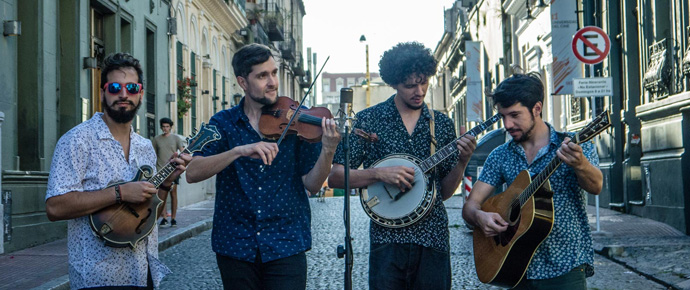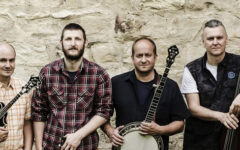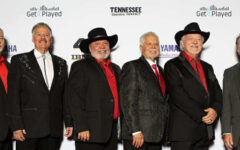
At first it seems like an unlikely combination at best — a bluegrass band that sings in Spanish and adds elements of Latin music to their material. Nevertheless, Che Apalache, a four-man string band based in Buenos Aires that includes players from Argentina, Mexico, and the United States, does just that. Led by fiddler Joe Troop, a singer, songwriter and multi-instrumentalist from North Carolinia who relocated to Argentina in 2010, he met his future compatriots — Pau Barjau (banjo), Franco Martino (guitar), and Martin Bobrik (mandolin) — while teaching music for a living, and ended up forming the band.
In the process, they evolved from bluegrass and grassicana — still a sound that’s a mainstay of their music — into an approach best described as “Latingrass,” which is also the title of their debut album. It’s a synthesis of styles that span from Appalachia to the Andes, as their bio states so succinctly. Last year a grant from both the North Carolina Humanities Council and the Virginia Foundation for the Humanities allowed them opportunity to tour the States, eventually garnering them a first place nod at the prestigious Appalachian String Band Music Festival in Clifftop, West Virginia.
Naturally, we were fascinated, so we spoke with Troop and asked him to share his backstory…
BLUEGRASS TODAY: For starters, is Argentinian Americana/grassicana/bluegrass a growing and potent movement? Just how popular is bluegrass in Argentina? Are there other bands doing the same thing?
JOE TROOP: Bluegrass was virtually nonexistent when I moved to Argentina in 2010. There was interest in bluegrass instruments though. I’ve taught hundreds of students banjo, fiddle, mandolin, and guitar. Few actually latched on and have taken it seriously, but I’d say there are now about 20 people I know of devoted to the style. There is another band called Angry Zeta in Buenos Aires that fuses bluegrass and punk that is getting popular. Actually, our bandmate Martin also plays banjo in that band. They kill it! There is also a growing folk music scene with weekly events and enthusiastic attendance. All in all, there is way more interest in Americana music than there was eight years ago when I moved here. Plus, Che Apalache does fusion, so we are able to rope in music lovers of all sorts. Much of our audience had never heard of bluegrass, but they related more immediately to our “latingrass” repertoire. Since then, they have slowly grown accustomed to Appalachian music and are beginning to dig it. We’re planting seeds, you could say.
What were the band members original influences?
I am from North Carolina and learned to play bluegrass from incredible regional musicians as a teenager. Two of my bandmates are Argentinians. Franco Martino’s father brought him up listening to and playing southern rock. He was already a great electric guitarist before coming to study bluegrass with me. He already understood many of the stylistic nuances. Martin Bobrik taught himself to play banjo on YouTube. He came to me for a lesson but was already ripping it. He began playing the mandolin to join Che Apalache. He’s a wiz kid and picks things up incredibly fast! The banjo player is Pau Barjau from Mexico. He’s my prized pupil. When he came to me for banjo lessons, he had never even heard of bluegrass. Actually, he was concentrating on electric bass, and got to the banjo through Victor Wooten’s collaborations with Béla Fleck. From the get go, he was interested in pushing the limits of the banjo. I’m a bit older than my bandmates. They started as my students, but when I realized they were were getting better than me, I was like, “Damn, I need to start a band with these guys!” I do most of the composing and song-writing. But we do the arrangements as a group. They happen very organically in our rehearsals. No writing things down — we just let it flow. We’re currently working on new material for a second album we’ll record in November.
What kind of response have you gotten to your music back home?
Back in Argentina we’re getting a great response in the independent music scene. What we do is considered avant-garde down there. This year we’re going to be touring throughout the country as well as doing a residency at a theater called Hasta Trilce in Buenos Aires. We’re beginning to attract attention in the country’s small and competitive independent music scene. We’ve also got some great momentum in the US. We just signed with the Herschel Freeman Agency out of Memphis and are extremely honored to be on his artist roster! Herschel understands what we’re going for. We are going to be touring all across the States from mid-July to mid-October.
What do you think makes bluegrass so popular around the globe? As an original American musical style, why do you think it translates so well in other parts of the world?
Bluegrass is not popular in Argentina and never will be. In fact, many people down there understandably reject all things USA, since American foreign policy has ravished Latin America for a long time. What I like about what we’re doing with Che Apalache is that we challenge people to get to know a very different United States, the one that produces an amazing arts culture. Many Latin Americans are deterred by the idea of North American culture, but we try to suggest to them a very different possibility. We are a tri-national fusion group, two parts Argentinian, one part Mexican, one part North Carolinian. We’re advocates for a unified, globally-minded America, from north to south.







